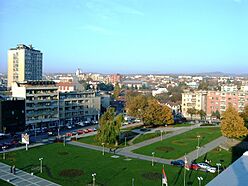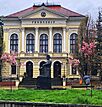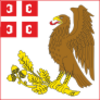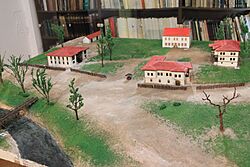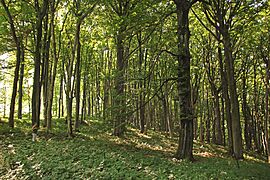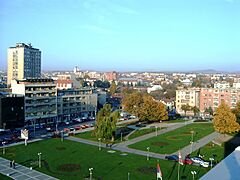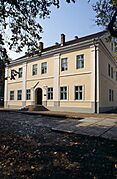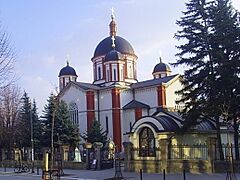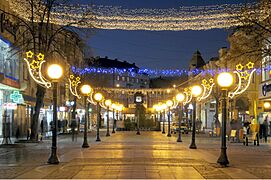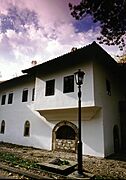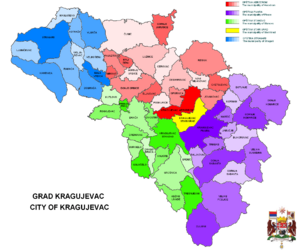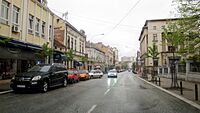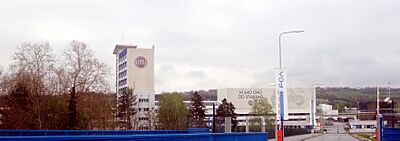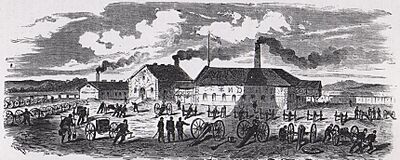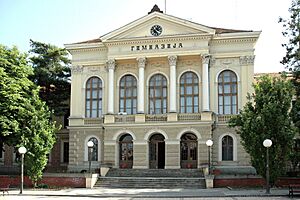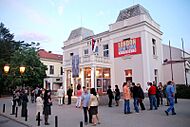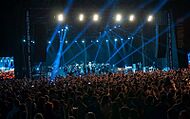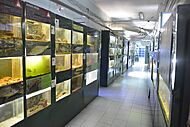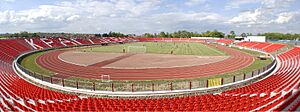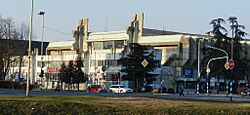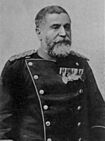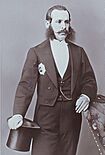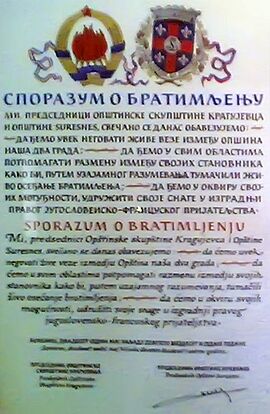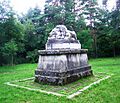Kragujevac facts for kids
Quick facts for kids
Kragujevac
Крагујевац (Serbian)
|
|||
|---|---|---|---|
| Град Крагујевац Grad Kragujevac City of Kragujevac |
|||
|
Panorama of Kragujevac
City Assembly Building
District Court
Kragujevac Cathedral
National Museum of Kragujevac
First Kragujevac Gymnasium
Second Kragujevac Gymnasium
Princely Serbian Theatre
The 21 October Museum
"Interrupted Flight" monument
|
|||
|
|||

Location of Kragujevac within Serbia.
|
|||
| Country | |||
| Region | Šumadija and Western Serbia | ||
| District | Šumadija | ||
| Founded | 1476 | ||
| Area | |||
| Area rank | 22nd in Serbia | ||
| • Urban | 82.83 km2 (31.98 sq mi) | ||
| • Administrative | 835 km2 (322 sq mi) | ||
| Elevation | 173 m (568 ft) | ||
| Population
(2022 census)
|
|||
| • Rank | 4th in Serbia | ||
| • Urban | 146,315 | ||
| • Urban density | 1,766.45/km2 (4,575.08/sq mi) | ||
| • Administrative | 171,186 | ||
| • Administrative density | 205.01/km2 (531.0/sq mi) | ||
| Time zone | UTC+1 (CET) | ||
| • Summer (DST) | UTC+2 (CEST) | ||
| Postal code |
СРБ-34 000
|
||
| Area code(s) | +381 34 | ||
| ISO 3166 code | SRB | ||
| Licence plates | KG | ||
Kragujevac (Serbian Cyrillic: Крагујевац) is the fourth largest city in Serbia. It is the main city of the Šumadija region in central Serbia. Kragujevac is located by the Lepenica River. In 2022, about 171,186 people lived in the city.
Kragujevac was the first capital of modern Serbia. The first constitution in the Balkans, called the Sretenje Constitution, was created here in 1835. During World War II, a terrible event known as the Kragujevac massacre happened here. Many Serb men and boys were killed by the Nazis.
Today, Kragujevac is known for making weapons (Zastava Arms) and cars (Fiat Serbia). It is also an important education center, home to the University of Kragujevac.
Contents
What's in a Name?
The name Kragujevac comes from the word 'kraguj'. This is the Serbian name for a large bird called the cinereous vulture. In the past, these birds were common in the area's forests. People used them for hunting. The city's name means 'kraguj's tower'. You can even see this bird on the city's coat of arms!
A Look at Kragujevac's Past
Early Times
People have lived in the Šumadija region for a very long time. More than 200 old sites show that the first humans lived here about 40,000 years ago. This was during the Paleolithic era, or Old Stone Age. Simple homes from 5,000 BC have been found near the city. These belong to the Neolithic Starčevo culture. Famous small statues called Divostinke (meaning "Girls from Divostin") were found here.
Later, around 9 AD, Illyrians and Celts lived in this area. Then, in the 6th and 7th centuries, Slavs settled here. The area became part of the First Bulgarian Empire. Around 1198, Stefan Nemanja, a Serbian prince, took control of the land.
The city was first written about in 1476. This was in an Ottoman record after they took control. It was called 'Kraguyfoça' and had 32 houses. By 1536, it had grown to 56 Muslim houses and 29 Christian houses.
Wars and New Beginnings
Kragujevac was often a place of fighting between the Habsburg monarchy and the Ottoman Empire. In 1718, it became part of the Habsburg Kingdom of Serbia. During this time, it was a town for Serbian soldiers. In 1725, the first official cases of vampirism were recorded in Kragujevac. This is how the Serbian word "vampir" became known in other languages!
The city was very important during the Serbian Revolution. This was when Serbs fought for their freedom. Kragujevac was first freed in 1804. It was finally free from Ottoman rule in 1815.
In 1818, Kragujevac became the capital of the Principality of Serbia. Prince Miloš Obrenović made it the capital. He built a royal home by the Lepenica river. The Amidža Konak is the only part of that complex still standing. It shows what 19th-century Ottoman buildings looked like.
Many important Serbian institutions started in Kragujevac. These include the first courthouse, the first grammar school (First Kragujevac Gymnasium), and the Princely Serbian Theatre. The first Serbian constitution, the Sretenje Constitution, was announced here in 1835. It was a very modern constitution for its time.
Growing into an Industrial City
Even though the capital moved to Belgrade in 1841, Kragujevac became more important. It grew into a city known for its factories. The city's first foundry, which made metal products, was built in 1835. This became the start of Zastava Arms, Serbia's main weapons maker. The first cannon was made here in 1853.
More industries quickly followed. The first telephone exchange was set up in 1858. The first industrial brewery opened in 1868. A printing press started in 1870. A railroad was built in 1886 to connect the city's factories to other parts of Serbia. The city also got its first grammar school, pharmacy, and cinema. The Great Park was built, and the city got its first urban plan in 1891.
Today, the old factory complex, called VTZ, is a protected cultural site. It has 151 buildings, with 31 of them specially protected. These include the old foundry, machine workshop, and the railroad bridge. This area, once called the 'Forbidden City', is now open to visitors.
World War I and II
During World War I, Kragujevac was again the capital of Serbia from 1914 to 1915. The army's main command was in the courthouse. A group of women doctors and nurses from Scotland, called the Scottish Women's Hospital, helped here from 1914 to 1915. Kragujevac lost about 15% of its people during the war.
After World War I, Kragujevac became part of the Kingdom of Yugoslavia. The city continued to grow culturally and economically. New theaters and factories were built.
However, during World War II, the city was taken over by the Nazis. A terrible event happened here between October 19 and 21, 1941. This was the Kragujevac massacre. Nearly 2,800 men and boys were killed. This included a whole class from the city's First Gymnasium. A monument to these students is now a symbol of the city. The massacre inspired a famous poem called Krvava Bajka (A Bloody Fairy Tale).
The city was freed from Nazi Germany on October 21, 1944.
Modern Kragujevac
After the war, Kragujevac kept developing its industries. It made cars, trucks, and weapons. The biggest factory was Zastava Automobiles. It once employed thousands of people.
The first car from Zastava Automobiles was made in 1955. It was the FIAT 750, made under a license from Fiat Automobiles. Over the next 30 years, more than five million cars were made. These cars were sold in 74 countries. The Yugo car, also known as the Zastava Korral, was one of the most famous cars made here.
In the 1990s, the city's factories faced problems due to international economic sanctions. Some parts of the city were also damaged during the 1999 NATO bombing of Yugoslavia.
Today, Kragujevac is still an important industrial city in Serbia. It has also grown with new students and people who moved here after the wars. The city is working on plans to develop its central areas by 2030. Old industrial areas are being turned into homes, shops, and places for education and culture.
City Layout and Transport
Kragujevac is about 180 meters (590 feet) above sea level. It is located in the valley of the Lepenica River. The city covers an area of 835 square kilometers (322 square miles). It is surrounded by the Rudnik, Crni Vrh, and Gledić mountains. Kragujevac is the main city of Šumadija, a region known for its rolling hills and fruit orchards.
-
Kragujevac is centre of Šumadija region
City Buildings and Parks
Kragujevac has buildings with many different styles. In the past, Ottoman and 19th-century Vienna Secession styles were important. Now, newer buildings are more common. You can see a mix of styles, including Brutalism, especially in the monuments to the Kragujevac massacre. Modern glass office buildings show the city's business goals.
Some important buildings include:
- The "old" church of Descent of the Holy Spirit, built in 1818.
- The Old Parliament, where the first parliament meeting was held in 1859.
- The Amidža Konak, an old residential house now used for exhibitions.
- The Prince Mihailo Konak, built in 1860, now the National Museum.
- The grammar school (gimnazija), built between 1885 and 1887. It was the first school of its kind in Serbia.
The Upper (Great) Park is the biggest park in Kragujevac. It was created in 1898 and has over 10 hectares (25 acres) of green space. It's a great place to relax and walk. There are also sports fields and swimming pools nearby. The Lower (Small) Park is in the city center. It has a monument to the people who died from Šumadija.
Ilina Voda park was started in 1900 and covers 7 hectares (17 acres). It has a fountain, small lakes, and a small zoo. A fun fact about this park is that it has the largest sculpture of Easter eggs in Europe! It's 3 meters (10 feet) high and made from recycled metal.
Getting Around
Kragujevac has good transportation. You can reach it from Belgrade using Serbian IB-class roads 24 and 25. Soon, the A1 motorway will also connect to the city.
Buses connect Kragujevac to almost all cities in Serbia. Buses to Belgrade leave very often. The main bus station is about a kilometer from the city center. You can also reach Kragujevac by train. The main train station is near the bus station.
Public transportation within Kragujevac is run by the City Traffic Agency. Two companies, Arriva Litas and Vulović Transport, operate 22 city bus lines and 14 lines to nearby rural areas. There are also taxi and car rental companies. The city has 10 parking lots and zoned street parking.
Weather in Kragujevac
Kragujevac has a humid subtropical climate. This means it has hot, humid summers and mild winters. The average temperature in July is 22.6°C (72.7°F). Winds usually blow from the southwest and northwest. In winter, they often blow from the southeast.
| Climate data for Kragujevac (1991–2020, extremes 1961–2020) | |||||||||||||
|---|---|---|---|---|---|---|---|---|---|---|---|---|---|
| Month | Jan | Feb | Mar | Apr | May | Jun | Jul | Aug | Sep | Oct | Nov | Dec | Year |
| Record high °C (°F) | 20.6 (69.1) |
25.2 (77.4) |
29.4 (84.9) |
32.0 (89.6) |
35.4 (95.7) |
39.4 (102.9) |
43.9 (111.0) |
40.5 (104.9) |
37.8 (100.0) |
34.7 (94.5) |
27.6 (81.7) |
21.0 (69.8) |
43.9 (111.0) |
| Mean daily maximum °C (°F) | 5.7 (42.3) |
8.2 (46.8) |
13.1 (55.6) |
18.4 (65.1) |
23.0 (73.4) |
26.9 (80.4) |
29.3 (84.7) |
29.6 (85.3) |
24.3 (75.7) |
18.8 (65.8) |
12.7 (54.9) |
6.5 (43.7) |
18.0 (64.4) |
| Daily mean °C (°F) | 1.3 (34.3) |
3.0 (37.4) |
7.1 (44.8) |
12.1 (53.8) |
16.7 (62.1) |
20.7 (69.3) |
22.6 (72.7) |
22.3 (72.1) |
17.3 (63.1) |
12.2 (54.0) |
7.4 (45.3) |
2.4 (36.3) |
12.1 (53.8) |
| Mean daily minimum °C (°F) | −2.4 (27.7) |
−1.3 (29.7) |
2.0 (35.6) |
6.1 (43.0) |
10.5 (50.9) |
14.4 (57.9) |
15.9 (60.6) |
15.6 (60.1) |
11.6 (52.9) |
7.2 (45.0) |
3.3 (37.9) |
−0.9 (30.4) |
6.8 (44.2) |
| Record low °C (°F) | −27.6 (−17.7) |
−24.4 (−11.9) |
−18.3 (−0.9) |
−5.8 (21.6) |
−0.6 (30.9) |
2.7 (36.9) |
7.2 (45.0) |
4.6 (40.3) |
−2.2 (28.0) |
−6.6 (20.1) |
−16.4 (2.5) |
−20.7 (−5.3) |
−27.6 (−17.7) |
| Average precipitation mm (inches) | 42.1 (1.66) |
40.1 (1.58) |
46.6 (1.83) |
54.3 (2.14) |
70.3 (2.77) |
77.2 (3.04) |
65.8 (2.59) |
56.0 (2.20) |
53.6 (2.11) |
54.2 (2.13) |
44.6 (1.76) |
47.0 (1.85) |
651.8 (25.66) |
| Average precipitation days (≥ 0.1 mm) | 12.8 | 12.5 | 11.6 | 11.9 | 13.4 | 11.3 | 9.3 | 7.6 | 9.7 | 10.2 | 10.7 | 12.8 | 133.8 |
| Average snowy days | 8.5 | 7.7 | 3.8 | 0.7 | 0.0 | 0.0 | 0.0 | 0.0 | 0.0 | 0.1 | 2.5 | 6.6 | 29.9 |
| Average relative humidity (%) | 79.5 | 74.9 | 68.5 | 66.6 | 69.4 | 67.7 | 64.2 | 65.3 | 70.7 | 75.4 | 76.7 | 80.8 | 71.6 |
| Mean monthly sunshine hours | 71.9 | 91.3 | 148.4 | 184.7 | 225.7 | 260.1 | 293.3 | 280.2 | 197.0 | 148.5 | 92.5 | 62.3 | 2,055.9 |
| Source: Republic Hydrometeorological Service of Serbia | |||||||||||||
City Areas and Villages
Kragujevac is made up of the main city and many smaller villages around it.
Here are some of the villages in the city of Kragujevac:
- Adžine Livade
- Baljkovac
- Beloševac
- Botunje
- Bukorovac
- Velika Sugubina
- Velike Pčelice
- Veliki Šenj
- Vinjište
- Vlakča
- Goločelo
- Gornja Sabanta
- Gornje Grbice
- Gornje Jarušice
- Gornje Komarice
- Grošnica
- Desimirovac
- Divostin
- Dobrača
- Donja Sabanta
- Donje Grbice
- Donje Komarice
- Dragobraća
- Drača
- Drenovac
- Dulene
- Đuriselo
- Erdeč
- Erdoglija
- Jabučje
- Jovanovac
- Kamenica
- Korman
- Kotraža
- Kutlovo
- Lužnice
- Ljubičevac
- Mala Vrbica
- Mali Šenj
- Maršić
- Masloševo
- Mironić
- Novi Milanovac
- Opornica
- Pajazitovo
- Poskurice
- Prekopeča
- Ramaća
- Resnik
- Rogojevac
- Trešnjevak
- Trmbas
- Ugljarevac
- Cvetojevac
- Cerovac
- Čumić
- Šljivovac
People of Kragujevac
In 2022, the city area had 171,186 people. About 70% of them are working age (15 to 64 years old). Many people work in metalworking and healthcare. Most adults have finished high school.
The city has good services. About 93% of the city has a water supply system. 78% has a sewage system. 72% has natural gas. And 92% has cell phone service.
Different Groups of People
Kragujevac is home to people from different backgrounds.
| Ethnic group | Population 2011 |
Population 2022 |
|---|---|---|
| Serbs | 172,052 | 159,305 |
| Romani | 1,482 | 1,444 |
| Yugoslavs | 175 | 286 |
| Montenegrins | 645 | 246 |
| Macedonians | 297 | 189 |
| Croats | 192 | 114 |
| Muslims | 97 | 58 |
| Russians | - | 57 |
| Gorani | 101 | 51 |
| Others | 4,376 | 9,436 |
| Total | 179,417 | 171,186 |
Kragujevac's Economy
Kragujevac has been an important center for industry and trade for over 200 years. It is famous for making cars and weapons. The old state-owned company, Zastava Automobiles, was bought by Fiat in 2008. The new company is called FCA Srbija. Other companies like Magneti Marelli and Johnson Controls also work with Fiat here.
Weapon making started in Kragujevac in 1853. Now, Zastava Arms is Serbia's main supplier of firearms. It sells over 95% of its products to more than 40 countries. Zastava Arms is part of Serbia's Defense Industry.
Other big companies in Kragujevac include Rapp Marine Group (making ship parts), Meggle AG (dairy products), and Unior Components (metal parts). Large stores like Metro Cash and Carry and Mercator also have operations here.
The Kragujevac Fair started in 2005. It has a large area for trade shows and exhibitions. Kragujevac also has a free economic zone. This helps businesses grow by offering special benefits.
Here's a quick look at where people work in Kragujevac (as of 2022):
| Activity | Total |
|---|---|
| Agriculture, forestry and fishing | 190 |
| Mining and quarrying | 27 |
| Manufacturing | 16,535 |
| Electricity, gas, steam and air conditioning supply | 760 |
| Water supply; sewerage, waste management and remediation activities | 1,030 |
| Construction | 2,411 |
| Wholesale and retail trade, repair of motor vehicles and motorcycles | 8,322 |
| Transportation and storage | 2,410 |
| Accommodation and food services | 2,172 |
| Information and communication | 1,336 |
| Financial and insurance activities | 828 |
| Real estate activities | 121 |
| Professional, scientific and technical activities | 2,365 |
| Administrative and support service activities | 1,675 |
| Public administration and defense; compulsory social security | 2,715 |
| Education | 4,847 |
| Human health and social work activities | 5,220 |
| Arts, entertainment and recreation | 984 |
| Other service activities | 866 |
| Individual agricultural workers | 722 |
| Total | 55,537 |
Life and Culture in Kragujevac
Learning and Schools
Kragujevac has 22 primary schools and 8 secondary schools. There are also 3 special schools for children with specific needs.
The University of Kragujevac was founded in 1976. It is the fourth largest university in Serbia. It has 12 faculties (departments) and two institutes. These are spread across six nearby cities. About 16,000 students attend the university.
The University Library in Kragujevac is a large science library. It has about 100,000 books and many research papers. It also has a gallery for art.
Arts and Fun
Kragujevac has many cultural places that are important for art. These include:
- The Knjaževsko-srpsko pozorište (theater), founded in 1835.
- The National Library "Vuk Karadžić", founded in 1866.
- The "Abrasević" cultural and artistic group, started in 1904.
- The "October in Kragujevac Memorial Park". This park remembers the sad events of October 21, 1941.
- The National Museum, which has collections about history, different cultures, and paintings.
- The "Old Foundry Museum", located in the old gun factory. It shows the history of industry in Kragujevac.
- The Historical Archives of Šumadija, which keeps old documents and records.
The city also hosts many cultural events each year. Some of these are:
- The International Festival of Chamber Choir Music.
- The International Small Forms Theatre Festival.
- Arsenal Fest, a popular music festival.
- The International Saloon of Antiwar Cartoons.
- The International Jazz Festival.
Sports in Kragujevac
Kragujevac is home to Čika Dača Stadium. This is the third largest stadium in Serbia. The biggest sports club in Kragujevac is Radnički. It has 19 different sports clubs, including football, athletics, volleyball, and handball. FK Radnički 1923 is the city's most successful football club. It plays in the top Serbian league. Kragujevac also has the oldest Serbian football club, FK Šumadija 1903.
KK Radnički is the city's main basketball team. The Radnički volleyball club is one of the best in Serbia. The VK Radnički Kragujevac water polo club has won the domestic league and the LEN Trophy.
The city also has a futsal (indoor football) club called KMF Ekonomac. This club has won the Serbian championship eight times!
Local News
|
Radio stations
|
TV stations
|
Newspapers
|
Famous People from Kragujevac
- Milan Obrenović II, Prince of Serbia
- Mihailo Obrenović III, Prince of Serbia
- Tomislav Nikolić, former President of Serbia
- Filip Kostić, Footballer
- Radomir Putnik, a famous Serbian Field Marshal
- Jovan Ristić, a former President of the Ministry of Serbia
- Dušan Simović, Chief of General Staff
- Nikola Koka Janković, sculptor
- Radoje Domanović, writer
- Zoran Spasojević, writer
- Dragan Todorović, writer and artist
- Milan Dedinac, poet
- Draginja Adamović, poet
- Dragiša Nedović, songwriter and musician
- Vidosav Stevanović, novelist
- Dragoslav Srejović, archaeologist and historian
- Nataša Kandić, founder of the Humanitarian Law Center
- Mirko Babić, actor
- Dragomir Bojanić Gidra, actor
- Branislav Jerinić, actor
- Gorica Popović, actor
- Nikola Rakočević, actor
- Milovan "Minimaks" Ilić, radio and TV host
- Bora Dugić, flautist
- Cune Gojković, singer
- Ljubica Marić, composer
- Marija Šerifović, singer and Eurovision winner
- Jelena Tomašević, singer
- Vesna Despotović, basketball player
- Stevan Pletikosić, sport shooter
- Nikola Lončar, basketball player
- Katarina Bulatović, handball player
- Marija Lojpur, handball player
- Jelena Milovanović, basketball player
- Predrag Đorđević, footballer
- Danko Lazović, footballer
- Stefan Ilić, footballer
- Aleksa Ristić, basketball player
- Đorđe Kostić, basketball player
- Ivan Nedeljković, basketball player
- Filip Popović, basketball player
- Slavko Perović (footballer)
- Filip Holender, Hungarian footballer
- Svetozar Andrejević, merchant and helper of others
Kragujevac Around the World
Kragujevac has special connections with cities around the world. These are called twin towns or sister cities.
|
City Friends and Partners
Kragujevac also works with other cities in friendly ways:
|
Images for kids
See Also
 In Spanish: Kragujevac para niños
In Spanish: Kragujevac para niños


